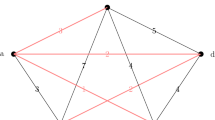Abstract
The abstract should summarize the contents of the paper and should contain at least 70 and at most 150 words. It should be set in 9-point font size and should be inset 1.0 cm from the right and left margins. There should be two blank (10-point) lines before and after the abstract. This document is in the required format. In this paper, we present a new algorithm for reconstructing large phylogenetic tree. This algorithm is based on a family of Disk-Covering Methods (DCMs) which are divide-and-conquer techniques by dividing input dataset into smaller overlapping subset, constructing phylogenetic trees separately using some base methods and merging these subtrees into a single one. Provided the high memory efficiency of RAxML (which the program inherited from fastDNAml) compared to other programs and the good performance on largereal-world data it appears to be best-suited for use as the base method. The experiments clearly show that the proposed algorithm improves over stand-alone RAxML on all datasets, i.e. yields better likelihood values than RAxML in the same amount of time. This results serve as an argument for the choice of the proposed algorithm instead of stand-alone RAxML.
This work is partially funded by a Research Foundation granted by the Shenzhen University under grant no: 4DZH), the National Natural Science Foundation of China under grant no. 60572100, the Royal Society (U.K.) International Joint Projects 2006/R3 - Cost Share with NSFC (China).
Access this chapter
Tax calculation will be finalised at checkout
Purchases are for personal use only
Preview
Unable to display preview. Download preview PDF.
Similar content being viewed by others
References
Smith, T.F., Waterman, M.S.: Identification of Common Molecular Subsequences. J. Mol. Biol. 147, 195–197 (1981)
Bull, J.J., Wichman, H.A.: Applied evolution. Annual Review of Ecology and systematics 32, 183–217 (2001)
Saitou, N., Nei, M.: The nigehbor-joining method: a new method for reconstructing phylogenetic tree. J Mol Evol 4, 406–425 (1987)
Bruno, W.J., Socci, N.D., Halpern, A.L.: Weighted Neighbor Joining: A Likelihood-Based Approach to Distance-Based Phylogeny Reconstruction. Mol Biol Evol 17, 189–197 (2000)
Gascuel, O.: BIONJ: an improved version of the NJ algorithm based on a simplemodel of sequence data. Mol Biol Evol 14, 685–695 (1997)
Desper, R., Gascuel, O.: Fast and Accurate Phylogeny Reconstruction Algorithms based on the Minimum-Evolution Principle. J Comput Biol 19, 687–705 (2002)
Ranwez, V., Gascuel, O.: Improvement of Distance-Based phylogenetic Methods by a Local Maximum Likelihood Approach Using Triplets. Mol Biol Evol 19, 1952–1963 (2002)
Camin, J., Sokal, R.: A method for deducing branching sequences in phylogeny. Evolution 19, 311–326 (1965)
Felsentein, J.: Evolutionary trees from DNA sequences: a maximum likelihood approach. J Mol Evol 17, 368–376 (1981)
Steel, M.A., et al.: Loss of information in genetic distances. Nature 336, 118 (1988)
Stelel, M.A.: The maximum likelihood point for a phylogenetic tree is not unique. Systematic Biology 43(4), 560–564 (1994)
Huelsenbeck, J.P., Ronquist, F.: MYBAYES: Bayesian inference of phylogenetic trees. Bioinformatics 17, 754–755 (2001)
Swofford, D.: PAUP*. Phylogenetic Analysis Using Parsimony (* and other mothods). Version 4.Sinauer Associates (2002)
Sjolander, K.: Phylogeneomi inference of protein molecular function: advances and challenges. Bioinformatics 20, 170–179 (2004)
Roshan, U.: Algorithm techniques for improving the speed and accuracy of phylogenetic methods. PhD thesis (2004)
Roshan, U., Moret, B.M.E., Warnow, T., Williams, T.L.: Rec-i-dcm3: a fast algorithmic technique for reconstructing large phylogenetic trees. In: Proceedings of the IEEE Computational Systems Bioinformatics conference (CSB), Stanford, California, USA (2004)
Huson, D., Nettles, S., Warnow, T.: Disk-covering, a fast-converging method for phylogenetic tree reconstruction. Journal of Computational Biology 6, 369–386 (1999)
Nakhleh, L., Roshan, U., St. John, K., Sun, J., Warnow, T.: Designing fast converging phylogenetic methods. In: Proc. 9th Int’l Conf. on Intelligent Systems for Molecular Biology (ISMB 2001). Bioinformatics, vol. 17, pp. S190–S198. Oxford U. Press, Oxford (2001a)
Warnow, T., Moret, B., St. John, K.: Absolute convergence: True trees from short sequences. In: Proc. 12th Ann. ACM-SIAM Symp. Discrete Algorithms (SODA 2001), pp. 186–195. SIAM Press, Philadelphia (2001)
Stamatakis, A., Ludwig, T., Meier, H.: Parallel inference of a 10.000-taxon phylogeny with maximum likelihood. In: Proceedings of 10th International EuroPar Conference, pp. 997–1004 (2004)
Stamatakis, A., Ludwig, T., Meier, H.: Raxml-iii:a fast program for maximum likelihood-based inference of large phylogenetic trees. Bioinformatics 21(4), 456–463 (2005)
Guindon, S., Gascuel, O.: A simple, fast, and accurate algorithm to estimatelarge phylogenies by maximum likelihood. Syst. Biol. 52(5), 696–704 (2003)
Maidak, B., et al.: The RDP (ribosomal database project) continues. Nucleic Acids Research 28, 173–174 (2000)
Wuyts, J., Van de Peer, Y., Winkelmans, T., De Watchter, R.: The European database on small subunit ribosomal RNA. Nucleic Acid Research 30, 183–185 (2002)
Author information
Authors and Affiliations
Editor information
Rights and permissions
Copyright information
© 2008 Springer-Verlag Berlin Heidelberg
About this paper
Cite this paper
Du, Z., Ji, Z. (2008). A New Algorithm for Reconstruction of Phylogenetic Tree. In: Li, H., Liu, T., Ma, WY., Sakai, T., Wong, KF., Zhou, G. (eds) Information Retrieval Technology. AIRS 2008. Lecture Notes in Computer Science, vol 4993. Springer, Berlin, Heidelberg. https://doi.org/10.1007/978-3-540-68636-1_50
Download citation
DOI: https://doi.org/10.1007/978-3-540-68636-1_50
Publisher Name: Springer, Berlin, Heidelberg
Print ISBN: 978-3-540-68633-0
Online ISBN: 978-3-540-68636-1
eBook Packages: Computer ScienceComputer Science (R0)




